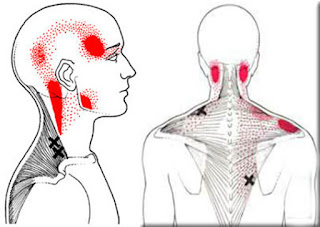Lumbar Vertebrae
Lumbar Vertebrae
Verebral Bodies
 |
Lumbar Vertebrae |
 |
| Structure Lumbare |
The Lumbar Vertebrae are larger and heavier than vertebral bodies in other regions. The lumbar vertebral body is kidney shaped when viewed superiorly, so is wider from side to side than from front to back, and a little thicker in front than in back with a thin cortial shell which surrounds cancellous bone. The posterior aspect of the vertebral body changes from slightly concave to slightly convex from L1 - L5 with an increasing diameter due to the increased load carried at each body.
The main weight of the body is carried by the vertebral bodies and disks. The lamina, facets and spinous process are major parts of the posterior elements that help guide the movement of the vertebrae and protect the spinal cord.
Vertebral Foramen
The vertebral foramen is triangular in shape and is larger than in the thoracic vertebrae but smaller than in the cervical vertebrae.
Bony Structures
Pedicles
The pedicles originate posteriorly and attach to the cranial half of the body forming the vertebral arch with the laminae. The pedicles become shorter and broader becoming more lateral from L1 - L5 which narrows the anteroposterior diameter and widens the transverse diameter of teh vertebral canal.
Laminae
Forming the Vertebral Arch with teh Pedicles the each laminae is flat and broad blending in centrally with the spinous process.
Spinous Processes
The spinous process are short and sturdy in teh Lumbar Vertebrae often described as "Hatchet-Shaped".
Transverse Processes
The transverese process are long and slender in the Lumbar Vertebrae with accessory processes on teh posterior surface on the base of each process.
Articular Processes
The superior articluar facets which are directed posteromedially or medially while the inferior articular facets are directed anterolaterally or laterally with a mamillary process on posterior surface of each superior articular process.
Physical examination
The physical examination of the intervertebral segment:
1.Active tests
1.1. Active movements: in standing, except for rotation which is best tested in sitting.
1.2. Auxiliary tests associated with active movements tests.
Isometric tests in the lumbar area produces considerable intervertebral movement. It may be necessary to test the muscle isometrically in differents positions of the joint range and to compare the degree of pain produced by an active resisted movement with that of a passive movement.
1.2. Auxiliary tests associated with active movements tests.
Isometric tests in the lumbar area produces considerable intervertebral movement. It may be necessary to test the muscle isometrically in differents positions of the joint range and to compare the degree of pain produced by an active resisted movement with that of a passive movement.
2.Passive tests
2.1. Movement of the pain-sensitive structures in the vertebral canal and intervertebral foramen.
2.2. Palpation: The positions of the vertebrae should be assessed in relation to adjacent vertebrae. Palpation of the spinous process posteriolly and laterally is usefull both in regard to the position of the vertebra and to the state of the interspinous and supraspinous ligaments. No too much importance should be placed on abnormalities found on this assesment, only relevant if they are verified by radiology.
2.3. Passive range or intervertebral movement.
2.2. Palpation: The positions of the vertebrae should be assessed in relation to adjacent vertebrae. Palpation of the spinous process posteriolly and laterally is usefull both in regard to the position of the vertebra and to the state of the interspinous and supraspinous ligaments. No too much importance should be placed on abnormalities found on this assesment, only relevant if they are verified by radiology.
2.3. Passive range or intervertebral movement.
Treatment
Invasive treatment
- percutaneous vertebroplasty : percutaneous intraosseous methylmethacrylate cement injection to treat osteoporotic vertebral compression fractures and spinal column neoplasms.
- kyphoplasty: Kyphoplasty is a type of vertebral augmentation for compression fractures.
- Lumbar Fusion: The goal of a lumbar fusion is to stop the pain at a painful motion segment in the lower back. Most commonly, this type of surgery is performed for pain and disability caused by lumbar degenerative disc disease or a spondylolisthesis.
There are also many surgical approaches to performing spinal fusion, such as ALIF, PLIF, XLIF, TLIF, posterolateral gutter fusion, anterior/posterior fusion, and certain minimally invasive approaches.
Physiotherapy
- Traction: Large forces are not required to separate the vertebrae. Vertebral separation could provide relief from radicular symptoms by removing direct pressure or contact forces from sensitised neural tissue.
- Therapeutic exercise: Exercise interventions, alone or in combination with other treatments, have a positive effect on diverse patologies, for example, low-back pain due to spondylolysis and spondylolisthesis. Exercise interventions can be considered aswell a preventive treatment because it has positive effects on bone mineral density, and exercise programs can prevent fractures due to falls.
- Postural taping uses tape applied to the skin to provide increased proprioceptive feedback about postural alignment, improve thoracic extension, reduce pain and facilitate postural muscle activity and balance.
- Manuel mobilisation: Physiotherapists use manual mobilisation for differents patologies of the lumbar spine. Good knowledge of the appropriate technique is needed as well as take into account some contraindications, for example, high velocity spinal manipulation techniques are contraindicated in individuals with osteoporosis.



Comments
Post a Comment